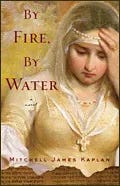The pivotal character in By Fire, By Water is the royal chancellor Luis de Santángel. He is the escribano de ración or "Comptroller of the Treasury" for King Fernando of Aragon. The historical Santángel persuaded Queen Ysabel to sponsor the westward voyage of Cristóbal Colón - Christopher Columbus. A converso, a Christian of Jewish ancestry, Santángel also fell afoul of Ysabel's infamous confessor, Tomás de Torquemada.
Besides Santángel, the novel offers the viewpoints of a beautiful Jewish woman, Torquemada, and various characters who either carry out the Inquisition's dirty work or suffer its effects. The climax is the eventful year 1492, which saw the reconquest of Granada, the expulsion of the Jews from Spain, and the authorization of Columbus's westward voyage in search of the Indies, along with the the Inquisition's intensified effort to root out conversos suspected of secretly practicing Judaism.
A result of the novel's huge scope is a tendency to skim the surface of events. Santángel remains on the periphery of the Spanish court, and his romance with Judith, a beautiful Jewish silversmith, never quite gels. Judith tells him, wisely but sadly, "Even the most powerful of us, we have little control over our destiny." Santángel’s lack of faith in himself and his ability to make a difference may be entirely credible, but it makes him a less than dynamic character to power a forward thrust to the novel.
But if By Fire, By Water never becomes deeply moving, it's not from lack of realism. It avoids errors like the old chestnut about Columbus startling people by claiming the world was round; his contemporaries were well aware of that fact but questioned whether the Earth was small enough for the Indies to be where Columbus thought they were (and, in fact, they were right). Readers may also be surprised to learn that Torquemada's brutality aroused controversy within the Church, as well it should have. This novel's fresh, research-based approach makes it a worthwhile fictional introduction to the era. (2010; 284 pages, including an Author's Note separating history from fiction)




